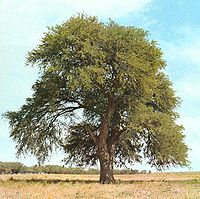
Photo from wikipedia
Abstract Robust evidence from phylogenomic analyses of 997 nuclear genes has recently shown, beyond doubt, that the genus Prosopis is polyphyletic with three separate lineages, each with affinities to other… Click to show full abstract
Abstract Robust evidence from phylogenomic analyses of 997 nuclear genes has recently shown, beyond doubt, that the genus Prosopis is polyphyletic with three separate lineages, each with affinities to other genera of mimosoids: (i) Prosopisafricana is an isolated lineage placed in the grade of Plathymenia, Newtonia and Fillaeopsis that subtends the core mimosoid clade; (ii) the remaining Old World species of Prosopis form a clade that is sister to the Indo-Nepalese monospecific genus Indopiptadenia and (iii) New World Prosopis has the Namibian / Namaqualand monospecific endemic genus Xerocladia nested within it. This means that it is now clear that maintaining the unity of the genus Prosopis sensu Burkart (1976) is no longer tenable. These three distinct lineages of Prosopis species correspond directly to Burkart’s (1976) sectional classification of the genus, to previously recognised genera and to the differences in types of armature that underpin Burkart’s sections. Here, we address this non-monophyly by resurrecting three segregate genera – Anonychium, Neltuma and Strombocarpa and provide 57 new name combinations where necessary, while maintaining the morphologically distinctive and geographically isolated genera Xerocladia and Indopiptadenia. The genus Prosopis itself is reduced to just three species and an emended description is presented. The impacts of these name changes for a genus of such high ecological and human use importance are discussed. These impacts are mitigated by clear differences in armature which facilitate identification and by potential benefits from the deeper biological understanding brought about by recognition of these divergent lineages at generic rank. We provide an identification key to genera and present a map showing the distributions of the segregate genera, as well as drawings and photos illustrating variation in armature and fruits.
Journal Title: PhytoKeys
Year Published: 2022
Link to full text (if available)
Share on Social Media: Sign Up to like & get
recommendations!